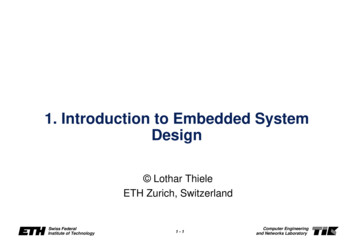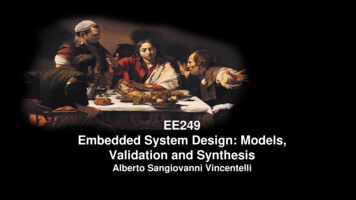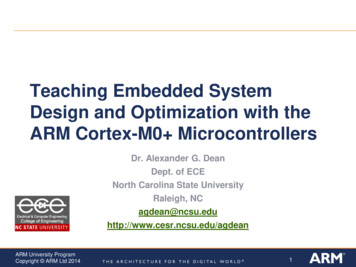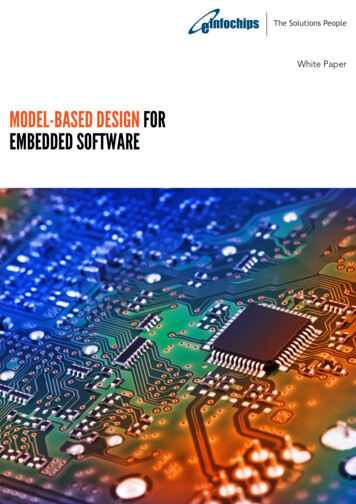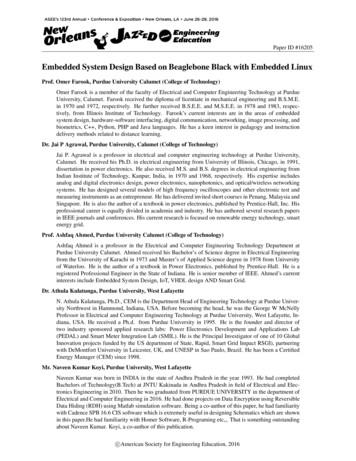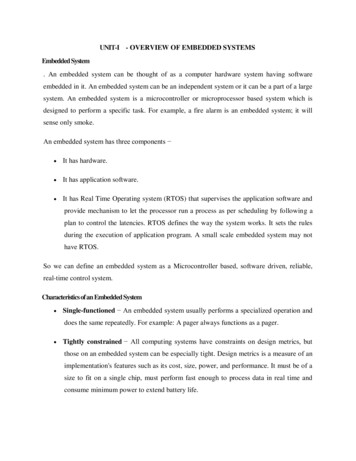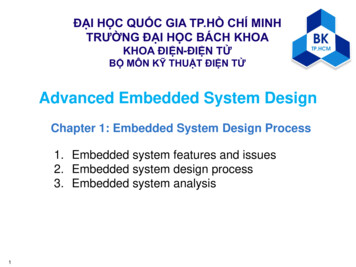
Transcription
ĐẠI HỌC QUỐC GIA TP.HỒ CHÍ MINHTRƯỜNG ĐẠI HỌC BÁCH KHOAKHOA ĐIỆN-ĐIỆN TỬBỘ MÔN KỸ THUẬT ĐIỆN TỬAdvanced Embedded System DesignChapter 1: Embedded System Design Process1. Embedded system features and issues2. Embedded system design process3. Embedded system analysis1
1. Embedded system features and issues Embedded system definition– any device that includes a programmable computer but is not itself ageneral-purpose computer - Wayne Wolf– An embedded computer system includes a micro-computer withmechanical,chemical and electrical devices attached to it,programmed for a specific dedicated purpose, and packaged as acomplete system - Jonathan W. Valvano– An embedded system is one that has computer-hardware withsoftware embedded in it as one of its most important component - RajKamalBộ môn Kỹ Thuật Điện Tử - ĐHBK2
1.1. Embedded System FeaturesCommon Features (Non-technical specification)CostApplicationsSize/WeightBộ môn Kỹ Thuật Điện Tử - ĐHBKSpeedPower/Energy3
1.1. Embedded System Features HARDWARE reROMEmbedded ProcessorButtonsSensorsRAMA/DI/OActuators Embedded processor is a heart of the embedded system:– micro-processor: 8086, ARM7/9/11, PowerPC, Nios– micro-controller: 8051, ARM Cortex-M, PIC16F, 68HC11, LM4F120 ,STM32F4Bộ môn Kỹ Thuật Điện Tử - ĐHBK4
1.1. Embedded System Features Memory– ROM: embedded program– RAM: processing data Peripheral interface––––GPIO, UART, I2C, SPIADC, PWMUSB, MicroSDEthernet, wifi User interface– Button / keypad / switch– LCD / 7-segment LED / LEDindicatorBộ môn Kỹ Thuật Điện Tử - ĐHBK Sensors– temperature, humidity, light,ultrasound, pressure– Motion sensor, gyroscope Actuators– motor, solenoid, relay, Clock– crystal Power– 5V / 3.3V / 2.5V– Battery, DC adapter, 5
1.1. Embedded System Features SOFTWARE FEATURES Operating system– Non-OS– RTOS, LynxOS, RTLinux– Linux, Android, WinCE Embedded programs– Supported functions– User applications– Software update User Interface– Command line– Text display– Graphic user interfaceBộ môn Kỹ Thuật Điện Tử - ĐHBK6
1.2. Embedded System Issues Design Issues1. Constraints––––cost may matter more than speedlong life cycleReliability/safetyLow-power2. Functions––safety-critical applicationsdamage to life, economy can result3. Real-time––Not only right output but at the right timeprocessing time is the most important one.Bộ môn Kỹ Thuật Điện Tử - ĐHBK7
1.2. Embedded System Issues4. Concurrency– System and environment run concurrently– multi-functional– interface with other systems5. Reactive systems– Once started run forever– Continuous interaction with their environment– termination is a bad behaviorBộ môn Kỹ Thuật Điện Tử - ĐHBK8
1.2. Embedded System Issues Basic requirements for an embedded systemReal-time/reactiveoperationCost /resourceSafe andreliableBộ môn Kỹ Thuật Điện Tử - ĐHBKSmall size/low weightLow power,cooling9
An embedded system example - 1A digital cameraDigital camera chipCCDCCD preprocessorPixel coprocessorD2AA2DlensJPEG codecMicrocontrollerMultiplier/AccumDMA controllerMemory controller Display ctrlISA bus interfaceUARTLCD ctrlConstraint: Low cost, low power, small, fastFunction: capture and store pictures / videosReal-time: only to a small extentConcurrent: single functionReactive: power on demandBộ môn Kỹ Thuật Điện Tử - ĐHBK10
An embedded system example - 2Battery charger Common features– Cost: Low Cost– Applications/Functions Ability to charge NiCd, NiMH, Li-Ion batteries User Selectable Charging Algorithms High Charge Current Capability– Speed: Fast Charge Rate– Size/weight: Small size, portable– Power/energy: 12V DC adapterBộ môn Kỹ Thuật Điện Tử - ĐHBK11
An embedded system example - 2 Battery Charger DesignBộ môn Kỹ Thuật Điện Tử - ĐHBK12
An embedded system example - 2Battery Charger Hardware features– Processor: PIC16F877A– Memory: 8k Flash ROM– Peripheral interface: GPIO, ADC, RS232– User interface: text LCD, LED, button, Jumper– Sensor: current sensor, voltage sensor– Actuator: 5A BJT– Clock: 16MHz– Power: 5VDCBộ môn Kỹ Thuật Điện Tử - ĐHBK13
An embedded system example - 2Battery Charger Software features– Operating system: Non-OS– Embedded programs Charging controlling Charging current, voltage displaying– User Interface Text LCD: displaying mode, current, voltageLED: indicating statusButton: selecting charging modeJumper: selecting battery typeBộ môn Kỹ Thuật Điện Tử - ĐHBK14
An embedded system example - 2 Design Issues– Constraints High charging current: 3A Safety: fuse protection, insulating box– Functions Charging process: bulk charge, absorption charge, float charge– Real-time system Non-critical real-time system Charging process based on predefined timer– Concurrent system Charging control and current/voltage display– Reactive system Non-continuous interactionBộ môn Kỹ Thuật Điện Tử - ĐHBK15
Quiz1.2.3.4.5.6.7.What is an embedded system?What are embedded system features?What are issues of embedded system design?What are five basic requirements of embedded system?What are common characteristics of an embedded system?What are optimizing design metrics?What is the most importance step of embedded system designprocess?8. What are three key technologies for embedded systems?9. Design features for the following design:1.2.3.Digital door lockDigital clock3D LED cubeBộ môn Kỹ Thuật Điện Tử - ĐHBK16
2. Embedded System Design ProcessRequirement definitionCAD toolsCustomersSystem specificationSystemarchitectsSystem architecture developmentSW development Application SW Compilers OperatingInterface design SW driver HW interface User interfaceSW developerHW design HW architecture HW synthesis Physical designHW designerIntegration and testingBộ môn Kỹ Thuật Điện Tử - ĐHBKReusedcomponents17
2.1. System SpecificationDocuments for System Specification1. Product Specification2. Engineering Specification3. Hardware Specification4. Software Specification5. Test SpecificationBộ môn Kỹ Thuật Điện Tử - ĐHBKDescribe how the product will be.Describe what board, subsystem, andfirmware will be used.Describe how the board will beimplemented and how it works.Describe how the software will beimplemented.Describe how the system will be tested.18
2.1. System Specification1. Product Specification:–––––What the system is to doWhat the user interface isWhat the real world I/O consists ofWhat the external interface to other system is (if any)What are the constraints? (speed, stability, low power, cost ) Example: Oven temperature control system––––Functions: control the heater and the fan of an ovenI/O: temperature sensor, heater port, fan portUser interface: LCD display, keypadExternal interface: UARTBộ môn Kỹ Thuật Điện Tử - ĐHBK19
2.1. System Specification2. Engineering Specification:– What kind of hardware will be used– What are the requirements for hardware and software Example: Oven temperature control system– 8051 microcontroller, LM35 sensor, LCD 16x2-B, ADC0809,RS232 IC– Requirements PID control algorithmreal-time processingDisplay current temperature valueable to set operating temperature valueTransfer data to computer through UARTBộ môn Kỹ Thuật Điện Tử - ĐHBK20
2.1. System Specification3. Hardware Specification:– The requirements from engineering documents– How the hardware implements the functionality– The software interfaces to the hardware Example: Oven temperature control system– PIC Microcontroller 12MHz, sensor LM35, LCD 16x2-B,Keypad 16, ADC0809, FET IRF260 for heater/fan control– Microcontroller reads temperature value from LM35through ADC, display this value to LCD, and then controlheater and fan based on PID control algorithmBộ môn Kỹ Thuật Điện Tử - ĐHBK21
2.1. System Specification4. Software Specification:– The requirements from engineering specification– Interface to other software– How the software implements the requirements Example: Oven temperature control system– design a function: void LCD display(String str) int PID control(int temp, int data[])Bộ môn Kỹ Thuật Điện Tử - ĐHBK22
2.1. Embedded System Design Process5. Test Specification:– The device, equipment, environment for testing– Prototype– Testing process Example: Oven temperature control system– Voltage meter, temperature meter– Prototype: bread board– Testing process: calibrate temperature sensorcheck LCD, keypadcheck output port (heater, fan)verify PID control algorithmBộ môn Kỹ Thuật Điện Tử - ĐHBK23
2.2. System architecture development Partitioning the system into three parts:– Interface design– Hardware design– Software development Methodology– Block diagram– Waveform– Function description– Coding guidelineBộ môn Kỹ Thuật Điện Tử - ĐHBK24
2.2. System architecture development Hardware block diagram– Use a rectangle for a hardware block– Use an arrow for a connection– Use a symbol for a special blockSpeakerLampEnergyBộ môn Kỹ Thuật Điện Tử - ĐHBKNetworkcomputerDatabase25
2.2. System architecture development Hardware block diagram - ExampleMOTOR CONTROLBộ môn Kỹ Thuật Điện Tử - ĐHBK26
2.2. System architecture development Software diagram: flowchart, state diagram–––––Use a rectangle for a processUse a rounded rectangle for a terminatorUse a diamond shape for a decisionUse a parallelogram for dataUse a rectangle with two vertical lines for predefine processNYBộ môn Kỹ Thuật Điện Tử - ĐHBK27
2.2. System architecture development Software block diagram - ExampleBộ môn Kỹ Thuật Điện Tử - ĐHBK28
2.2. System architecture development Interface design– Show the connections between hardware and software– Show the connections with other systems– Show the interface with usersExamplesBộ môn Kỹ Thuật Điện Tử - ĐHBK29
2.2. System architecture development Interface design – example :Interface design for a dental camera systemBộ môn Kỹ Thuật Điện Tử - ĐHBK30
2.2. System architecture development Diagram software tools– Microsoft Visio– Gliffy– Lucid chartBộ môn Kỹ Thuật Điện Tử - ĐHBK31
2.3. Integration and Testing Integration process– Configuration Define configurations, parameters, versions– Hardware integration integrate microprocessor, peripherals, sensors,actuators, user interfaces– Software integration integrate OS, drivers, functions,– System integrationBộ môn Kỹ Thuật Điện Tử - ĐHBK32
2.3. Integration and Test Testing process– Hardware testing CPUPeripheral interfaceSensorActuatorUser interface– Software testing Operating system, drivers Applications/functions User interface– Hard/soft co-testing Test casesBộ môn Kỹ Thuật Điện Tử - ĐHBK33
3. Embedded System Analysis1. Technology selection2. System optimization3. Cost analysisBộ môn Kỹ Thuật Điện Tử - ĐHBK34
3.1. Technology Selection Technology– A manner of accomplishing a task, especially using technicalprocesses, methods, or knowledge Three key technologies for embedded systems– Processor technology: general-purpose, application-specific,single-purpose– IC technology: Full-custom, semi-custom, PLD– Design technology: Compilation/synthesis, libraries/IP,test/verification35Bộ môn Kỹ Thuật Điện Tử - ĐHBK
3.1. Technology Selection Processor selection–––––––number of IO pins requiredinterface requiredmemory requirementsnumber of interrupts requiredreal-time considerationsdevelopment environmentprocessing speed requiredGeneral-purposeprocessorBộ môn Kỹ Thuật Điện Tử - ocessor36
Processor technology “Processor” not equal to general-purpose processorControllerControllogic ControllerControllogic morytotal 0for i 1 to General-purpose (“software”)37Bộ môn Kỹ Thuật Điện Tử - ĐHBKControllogicStateregisterDatapathindextotal PCDatamemoryProgrammemoryAssemblycode for:ControllerDatamemoryProgrammemoryAssemblycode for:total 0for i 1 to Application-specificSingle-purpose (“hardware”)
IC technology The manner in which a digital (gate-level)implementation is mapped onto an IC– IC: Integrated circuit, or “chip”– IC technologies differ in their customization to a design– IC’s consist of numerous layers (perhaps 10 or more) IC technologies differ with respect to who builds each layer andwhenIC package38ICBộ môn Kỹ Thuật Điện Tử - ĐHBKgateoxidesource channel drainSilicon substrate
3.2. System Optimization Hardware / software partitioning– which functions should be performed in hardware, andwhich in software?– the more functions in software, the lower will be theproduct costBộ môn Kỹ Thuật Điện Tử - ĐHBK39
3.2. System OptimizationDesign challenge – optimizing design metrics Common metrics1. Unit cost: the monetary cost of manufacturing each copy of thesystem, excluding NRE cost2. NRE cost (Non-Recurring Engineering cost): The one-timemonetary cost of designing the system3.4.5.6.40Size: the physical space required by the systemPerformance: the execution time or throughput of the systemPower: the amount of power consumed by the systemFlexibility: the ability to change the functionality of the systemwithout incurring heavy NRE costBộ môn Kỹ Thuật Điện Tử - ĐHBK
3.2. System Optimization Common metrics (continued)7. Time-to-prototype: the time needed to build a working version ofthe system8. Time-to-market: the time required to develop a system to thepoint that it can be released and sold to customers9. Maintainability: the ability to modify the system after its initialrelease10. Correctness: check the functionality throughout the process ofdesigning the system; insert test circuitry to check that manufacturingwas correct11. Safety: the probability that the system will not cause harm41Bộ môn Kỹ Thuật Điện Tử - ĐHBK
The performance design metric Widely-used measure of system, widely-abused– Clock frequency, instructions per second – not good measures– Digital camera example – a user cares about how fast it processes images, notclock speed or instructions per second Latency (response time)– Time between task start and end– e.g., Camera’s A and B process images in 0.25 seconds Throughput– Tasks per second, e.g. Camera A processes 4 images per second– Throughput can be more than latency seems to imply due to concurrency, e.g.Camera B may process 8 images per second (by capturing a new image whileprevious image is being stored). Speedup of B over S B’s performance / A’s performance– Throughput speedup 8/4 242Bộ môn Kỹ Thuật Điện Tử - ĐHBK
3.2. System OptimizationDesign metric competition -- improving one may worsen others Expertise with both software and hardware is needed tooptimize design metrics– Not just a hardware or software expert, as is common– A designer must be comfortable with various technologies in order tochoose the best for a given application and constraintsPowerPerformanceSizeNRE costBộ môn Kỹ Thuật Điện Tử - ĐHBK43
Improving productivity Design technologies developed to improve productivity We focus on technologies advancinghardware/software unified viewAutomationSpecification– Automation Program replaces manual design Synthesis– ReuseVerificationImplementation Predesigned components Cores General-purpose and single-purpose processors on single IC– Verification Ensuring correctness/completeness of each design step Hardware/software co-simulation44Bộ môn Kỹ Thuật Điện Tử - ĐHBKReuse
3.3. Cost Analysis Time required to develop a product to the point it can be soldto customers Market window– Period during which the product would have highest salesRevenues ( ) Average time-to-market constraint is about 8 months Delays can be costlyTime (months)Bộ môn Kỹ Thuật Điện Tử - ĐHBK45
Losses due to delayed market entry Simplified revenue model– Product life 2W, peak at W– Time of market entry defines a triangle, representing market penetration– Triangle area equals revenue Loss– The difference between the on-time and delayed triangle areasRevenues ( )Peak revenuePeak revenue fromdelayed entryOn-timeMarket fallMarketriseDelayedDOn-timeentryBộ môn Kỹ Thuật Điện Tử - ĐHBKDelayedentry2WWTime46
Losses due to delayed market entry (cont.) Area 1/2 * base * height– On-time 1/2 * 2W * W– Delayed 1/2 * (W-D W)*(W-D) Percentage revenue loss (D(3W-D)/2W2)*100%Revenues ( )Peak revenuePeak revenue fromdelayed ll2WWDelayedentryTimeBộ môn Kỹ Thuật Điện Tử - ĐHBKTry some examples– Lifetime 2W 52 wks, delayD 4 wks– (4*(3*26 –4)/2*26 2) 22%– Lifetime 2W 52 wks, delayD 10 wks– (10*(3*26 –10)/2*26 2) 50%– Delays are costly!47
NRE and unit cost metrics Costs:– Unit cost: the monetary cost of manufacturing each copy of the system,excluding NRE cost– NRE cost (Non-Recurring Engineering cost): The one-time monetary cost ofdesigning the system– total cost NRE cost unit cost * # of units– per-product cost total cost / # of units (NRE cost / # of units) unit cost Example– NRE 2000, unit 100– For 10 units– total cost 2000 10* 100 3000– per-product cost 2000/10 100 300Amortizing NRE cost over the unitsresults in an additional 200 per unitBộ môn Kỹ Thuật Điện Tử - ĐHBK48
NRE and unit cost metrics Compare technologies by costs -- best depends on quantity– Technology A: NRE 2,000, unit 100– Technology B: NRE 30,000, unit 30– Technology C: NRE 100,000, unit 2 200,000BC 120,000 80,000 0 016002400Numb er of units (volume)C 80 40800B 120 40,0000A 160p er p rod uc t c ost 160,000tota l c ost (x1000) 200A080016002400Numb er of units (volume) But, must also consider time-to-marketBộ môn Kỹ Thuật Điện Tử - ĐHBK49
Class assignment Design a embedded system for washing on-Washing process: soak, wash, rinse, spin-Mode: manual, -Outputs:-Use s:-Control algorithm:5Testspecification-Platform:-Test process:Bộ môn Kỹ Thuật Điện Tử - ĐHBK50
Class assignment1.2.3.4.Consider the following embedded systems: a pager, a computer printer, andan automobile cruise controller. Create a table with each example as acolumn, and each row one of the following design metrics: unit cost,performance, size, and power. For each table entry, explain whether theconstraint on the design metric is very tight. Indicate in the performanceentry whether the system is highly reactive or not.List three pairs of design metrics that may compete, providing an intuitiveexplanation of the reason behind the competition.The design of a particular disk drive has an NRE cost of 100,000 and a unitcost of 20. How much will we have to add to the cost of the product tocover our NRE cost, assuming we sell: (a) 100 units, and (b) 10,000 units.(a) Create a general equation for product cost as a function of unit cost,NRE cost, and number of units, assuming we distribute NRE cost equallyamong units. (b) Create a graph with the x-axis the number of units and they-axis the product cost, and then plot the product cost function for an NREof 50,000 and a unit cost of 5.Bộ môn Kỹ Thuật Điện Tử - ĐHBK51
Class assignmentConsider the project car door mechanismWrite system specification for this projectBộ môn Kỹ Thuật Điện Tử - ĐHBK52
– An embedded computer system includes a micro-computer with mechanical, chemical and electrical devices attached to it, programmed for a specific dedicated purpose, and packaged as a complete system-Jonathan W. Valvano – An embedded system is one that has computer-hardware with software embedded





